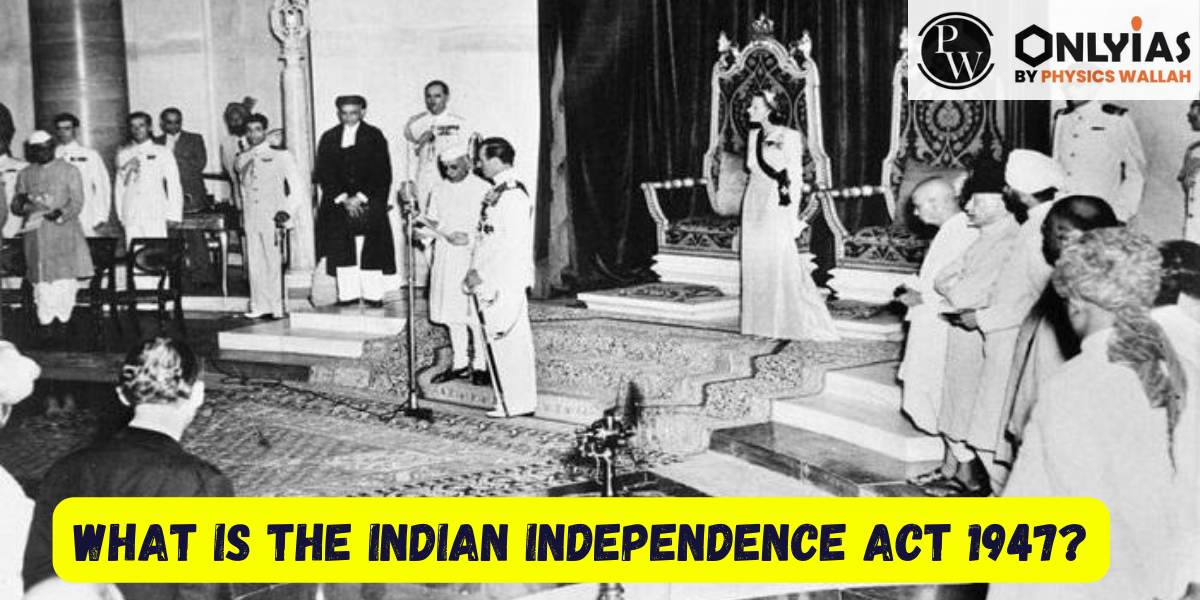
Indian Independence Act 1947: The Indian Independence Act of 1947, also known as the Mountbatten Plan, was a crucial piece of legislation passed by the British Parliament that marked the end of British colonial rule in India. Enacted on July 18, 1947, this historic act led to the partition of British India into two separate and independent nations – India and Pakistan. The act not only granted freedom to India but also set the stage for the birth of two new countries and reshaped the political landscape of the subcontinent. In this article, we will explore the key provisions and implications of the Indian Independence Act 1947.
The Indian Independence Act of 1947 marked a watershed moment in India’s history, signaling the end of British colonial rule and the beginning of a new chapter for the subcontinent. While it granted freedom to India and Pakistan, it also led to a painful partition that scarred the region. Despite the challenges and complexities, the act laid the groundwork for two sovereign nations, each on its unique path of development. The legacy of this historic legislation continues to shape the political, social, and cultural fabric of India and Pakistan, serving as a reminder of the long and arduous struggle for independence and the spirit of resilience that defines the subcontinent.

The struggle for Indian independence had gained momentum under the leadership of Mahatma Gandhi and numerous other freedom fighters who tirelessly fought for the country’s autonomy. The British government finally recognized the need to grant independence to India due to various factors, including the Indian National Congress’s persistent demand for self-rule and the aftermath of World War II, which weakened Britain’s hold on its colonies. The Indian Independence Act was a significant step towards ending over two centuries of British colonial rule in India.
One of the most profound consequences of the Indian Independence Act 1947 was the partition of British India into two separate nations – India and Pakistan. The act proposed the establishment of two dominions, India and Pakistan, with the latter comprising two regions – East Pakistan (present-day Bangladesh) and West Pakistan (present-day Pakistan). The division was primarily based on religious lines, with Pakistan created as a separate homeland for Muslims.
The Indian Independence Act set a definite timeline for the transfer of power from British rule to Indian hands. According to the act, India would gain independence on August 15, 1947. On this historic day, the British Crown’s authority over India would cease, and the dominion of India would become a sovereign nation. Lord Mountbatten, the last Viceroy of India, played a crucial role in overseeing the transition of power during this period.
The act also addressed the issue of princely states – semi-autonomous territories ruled by local monarchs. These princely states were given the option to either accede to India, Pakistan, or remain independent. The Indian Independence Act stipulated that if the majority of a princely state’s population was of a particular religious community, the state would accede to the corresponding dominion.
The partition of British India was marred by communal tensions and widespread violence, resulting in tragic loss of lives and large-scale migrations. The partition led to a massive population exchange, with millions of Hindus and Sikhs moving to India and Muslims migrating to Pakistan. The communal violence during this period remains a dark chapter in the history of the subcontinent.
The Indian Independence Act 1947 had far-reaching consequences for the newly independent nations. India embarked on a journey to build a secular and democratic republic, while Pakistan became the world’s first Islamic republic. The act set the foundation for the development of the respective countries’ constitutions and governance structures. Moreover, it also left a lasting impact on the region’s geopolitics and relations between India and Pakistan, which continue to shape the subcontinent’s history.
The Indian Independence Act of 1947, a historic legislation that brought an end to British colonial rule in India, was characterized by several salient features that shaped the course of India and Pakistan’s destinies. Let us explore these features and evaluate their impact on the subcontinent.
1. Declaration of Independence:
The Act declared India as an independent and sovereign state, marking the end of British control over the country. This momentous declaration laid the foundation for India’s journey as a self-governing nation.
2. Partition and Creation of Dominions:
The Act provided for the partition of India, resulting in the creation of two new dominions – India and Pakistan. The division was based on religious lines, with Pakistan becoming a homeland for Muslims. However, this partition led to immense communal tensions and violence, leaving a lasting impact on the region.
3. Abolishment of Secretary of State for India:
The Act abolished the position of Secretary of State for India, which had played a crucial role in administering British India. This move symbolized the transfer of power and authority to the Indian people.
4. Establishment of Governor-General:
With the abolishment of the Viceroy’s office, the Act provided for the appointment of a Governor-General for each dominion, who would act on the aid and advice of the respective dominion cabinets. This granted greater autonomy to the dominions.
5. Empowerment of Constituent Assemblies:
The Act empowered the Constituent Assemblies of India and Pakistan to draft and adopt their respective constitutions, thereby giving them the authority to frame the fundamental laws of their nations.
6. Princely States’ Freedom to Choose:
Princely states were given the freedom to decide whether to accede to India, Pakistan, or remain independent. This provision led to significant political negotiations and decisions on the accession of various princely states.
1. Unforeseen Consequences of Partition:
While the Act paved the way for independence, the partition of India had unforeseen consequences. The lack of clarity on borders has led to ongoing disputes between India and Pakistan, especially concerning regions like Jammu and Kashmir.
2. Rise in Communal Feelings:
Partition led to increased religious homogeneity in Pakistan, but it also fueled communal feelings and suspicion between religious communities in both India and Pakistan. Minorities in Pakistan faced challenges due to the Islamization of life since the 1980s.
The Indian Independence Act of 1947 encompassed several crucial provisions that shaped the course of India’s history. Let’s examine some of the essential provisions that emerged after its enactment:

Economic Setup of India: Projected to be 3rd in Global Economy by FY28 – SBI Ecowrap
The primary objective of the Indian Independence Act was to facilitate the transfer of power from the British Crown to the newly independent dominions of India and Pakistan. By enacting this legislation, British suzerainty over Indian affairs came to an end, and the act was based on the Mountbatten Plan, which was devised by Louis Mountbatten, the last Governor-General of India.
The Indian Independence Act of 1947, a legislative measure passed by the British Parliament, resulted in the partition of India into two distinct and independent dominions - India and Pakistan. The drafting of this historic legislation was undertaken by the Labour government under the leadership of Clement Attlee.
Main Provisions of the Indian Independence Act 1947: 1. Creation of Independent Dominions: The Indian Independence Act of 1947 outlined the establishment of two separate and independent dominions - India and Pakistan. This momentous event was scheduled for August 15, 1947. Pakistan's territory would consist of Sindh, Baluchistan, the North-West Frontier Province (N.W.F.P), West Punjab, and East Bengal, while the remaining territories would be included within India. 2. Commencement of Independence: The act set August 15, 1947, as the day when both India and Pakistan would attain their sovereignty and become self-governing nations. On this momentous occasion, the British Crown's authority over these dominions would cease, and they would be free to govern themselves.
On August 14th, at 11 pm, the Constituent Assembly of India held its fifth session in New Delhi's Constitution Hall. Chaired by President Rajendra Prasad, the historic gathering witnessed Jawaharlal Nehru delivering the iconic "Tryst with Destiny" speech, proclaiming India's independence.

<div class="new-fform">
</div>